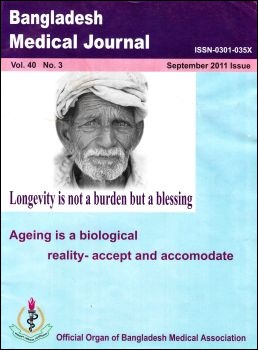Household Food Security and Nutritional Status of Rural Elderly
DOI:
https://doi.org/10.3329/bmj.v40i3.18649Abstract
Household food security is an emerging public health issue and the rural elderly people are one of the most vulnerable groups for the household food security. This cross-sectional study was conducted in Barobaria union of Gofargaon upazila of Mymensingh district to assess the nutritional status of rural elderly (?60 years) in relation to the household food security. A total of 118 purposively selected elderly were interviewed and measured for height and weight following a standard protocol. The mean (SD) age of the respondents was 68.6 (7.3) years and gender participation was equally represented. Majority (68.6%) of the respondents was illiterate and 92% were Muslims. Mean family size and monthly family income was estimated to be 5.5 and Taka 6106, respectively and 70% of the rural elderly were found to be dependent on their family members as they were not involved in income generation and most of the respondents were the members of joint family. Only about 29% of the total elderly were at the highest quarter of food security. Illiteracy, members of single family and larger family were found to be significantly associated with lower level of household food security (p < 0.05). Although age, sex, personal income and occupational category had no significant association, the total family income was significantly associated with household food security. Among the respondents 56% were underweight including 13% with severe chronic energy deficiency. Only 5.9% were overweight. Illiterates were three times more likely to be underweight than literates (OR 2.95 with 95% CI 1.32, 6.59). Smoking, lower family income, poor housing, single family, irregularity in treatment were significantly associated with underweight. A significant difference was found between mean body mass index of different household food security level (F =3.22, p < 0.05). There was gradual increase of mean body mass index with the improved status of food security level. Policy makers, therefore, need to consider programs that empower people to solve the problem of food insecurity and to improve the nutritional status of rural elderly people.
DOI: http://dx.doi.org/10.3329/bmj.v40i3.18649
Bangladesh Medical Journal 2011 Vol.40(3):8-11
Downloads
232
389

